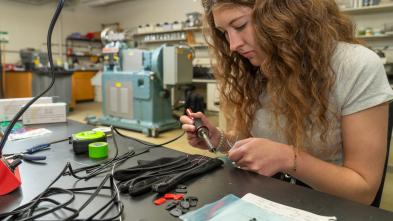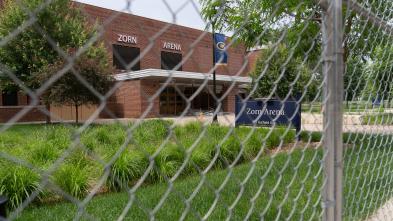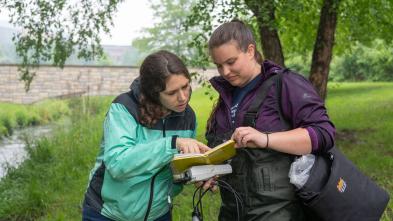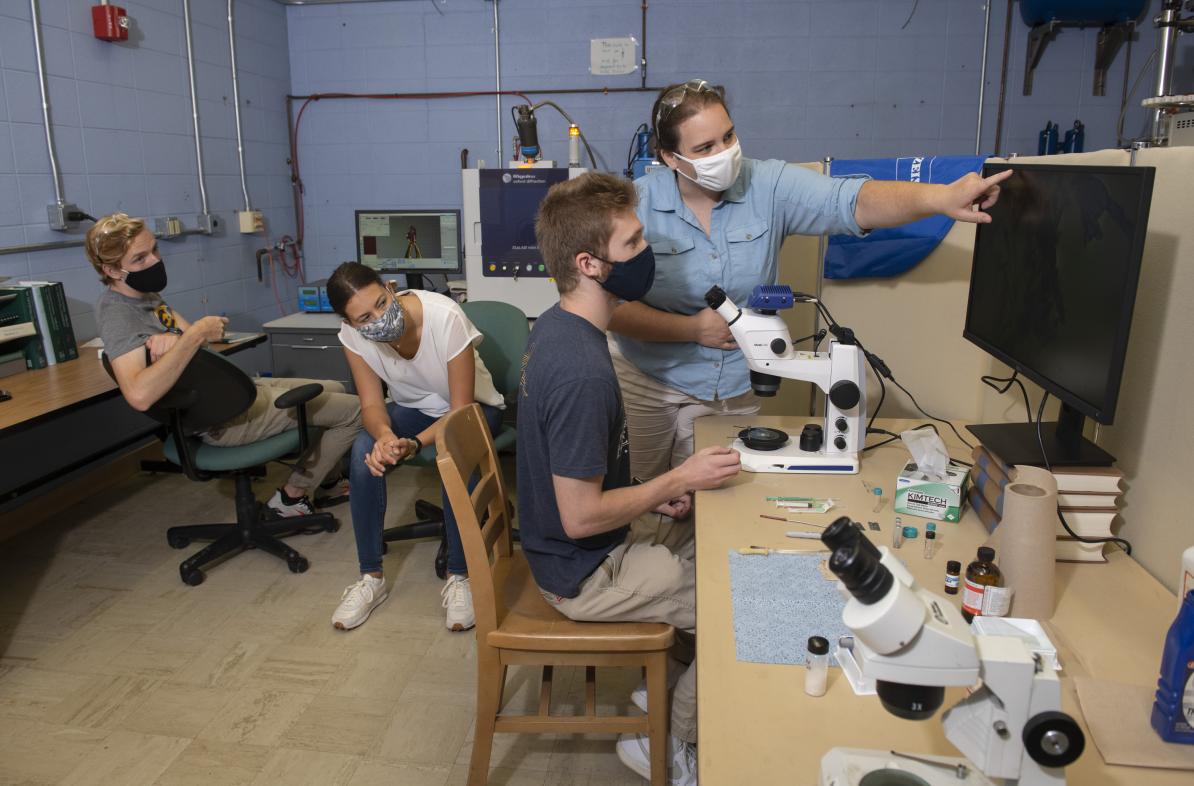
Students use new state-of-the-art instruments in summer research project
A team of student researchers at the University of Wisconsin-Eau Claire is using recently installed state-of-the-art instrumentation to try to make the chemical compounds that are in high-performance plastics — such as those found in the automotive industry — more energy efficient.
“We’re making a compound that will coordinate with metal and will cut a long carbon chain into smaller sections,” says Cole Birch, a senior biochemistry and molecular biology major from New Richmond. “We’re trying to make a more energy-efficient way to make products that already are in existence.”
Birch is working on the catalysis research project with UW-Eau Claire students Gorana Puzovic, a neuroscience major from the Republic of Serbia; and Connor Dolan, a biochemistry molecular biology major from Nekoosa.
High-end instrumentation
The project, led by Dr. Deidra Gerlach, an assistant professor of chemistry and biochemistry, is possible because of the chemistry and biochemistry department’s new X-ray diffractometer, an instrument used for a variety of purposes including analysis of crystals of organic and inorganic small molecules at the atomic level.
“This XRD instrument is novel — only a handful of undergraduate departments have such instrumentation,” says Dr. Jim Phillips, professor and chair of the chemistry and biochemistry department. “Having this kind of instrumentation in the department sets our chemistry and biochemistry programs apart by enhancing our student research experiences.”
For their project, Gerlach’s student researchers are working to build molecules that will speed up chemical reactions. Since molecules cannot be seen at the macro level, specialized equipment, like the XRD, is needed for the students to determine if the molecule they create is what they’d intended.
“It’s awesome because I can see my molecule,” Birch says of the XRD. “It’s really cool. It gives you a model of what it looks like. It gives me a model that confirms that what I wanted to create is what I got.”
The XRD — installed in fall 2020 — was purchased after Gerlach secured a nearly $105,000 National Science Foundation for Major Research Instrumentation grant. Gerlach, a 2007 UW-Eau Claire graduate who joined her alma mater’s faculty in 2019, is the first first-year UW-Eau Claire faculty member to be awarded an NSF-MRI grant.
“It is highly unusual for a first-year faculty member to receive a grant from the National Science Foundation,” says Dr. Mike Carney, an associate vice chancellor for academic affairs and a professor of chemistry and biochemistry at UW-Eau Claire. “Typically, NSF grants are awarded to more senior faculty after they’ve established a track record in their research program.
“Dr. Gerlach saw a need for a key piece of instrumentation in the department and spearheaded an effort to write the grant proposal, which was ultimately successful.”
Taking the lead on writing the NSF grant proposal was challenging, but worth the effort, says Gerlach, noting that her colleagues provided critical help and support.
“It got us an instrument that we very much needed,” says Gerlach, who has a background in crystallography. “The XRD we had hadn’t been running for 10 years.”
While the XRD is used by student researchers, it benefits many other science students because it makes crystallography accessible to students in teaching laboratories. The instrument is so advanced that students can collect and analyze data in as little as an hour, making it a valuable teaching tool.
The new diffractometer also has a small footprint, operates without special utility or environmental needs and has dramatically lower cost of ownership, all fitting the campus goals for sustainability.
Still another benefit is that the instrument is helping Gerlach to establish partnerships with researchers at other universities who don’t have access to their own XRD. Those partnerships help to strengthen UW-Eau Claire’s reputation, which benefits current students and graduates, she says.
Many industries, such as the food industry and the pharmaceutical industry, rely on XRDs, so knowing how to use the instrumentation can give students an edge when they are looking for jobs, Gerlach says.
“It’s a niche area of expertise,” Gerlach says. “So, being aware of how it works, and the care it takes to handle the instrumentation and samples is a great skill set to have on a resume.”
Expanding opportunities
The new X-ray diffractometer is used for a variety of purposes, including analysis of crystals of organic and inorganic small molecules at the atomic level.
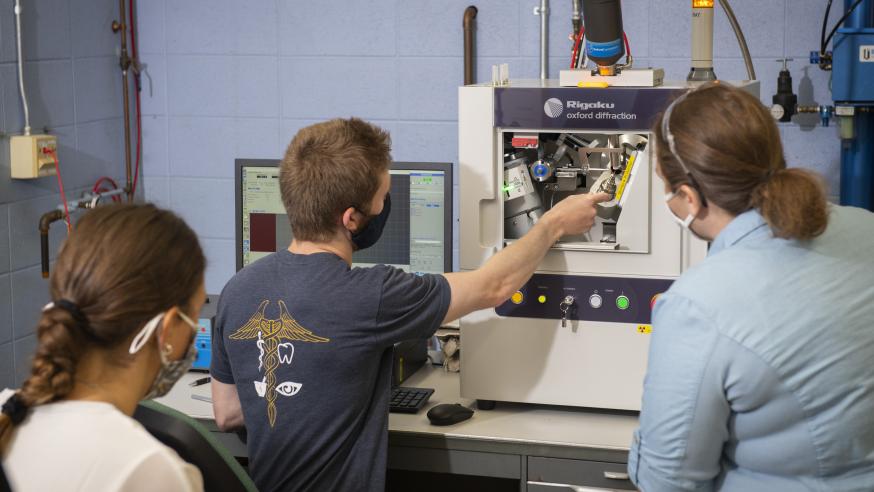
While Gerlach’s big-picture goal for her research team’s project is for it to help improve the environment through contributions to alternative energies, her primary focus is on making sure her students learn skills and grow their thinking in ways that will help them be successful after college.
“I see my research as a means to giving students experiences,” Gerlach says. “Doing groundbreaking things is not a huge interest of mine. I’m looking for projects that give students a wide array of skills. If we do something interesting, we will publish it because that’s good for the students. But my priority is giving them experiences that help them learn and think differently.”
Creating opportunities for students to access high-end instrumentation — such as the XRD — to address a research question is one way to achieve that goal, Gerlach says. Through research, students learn to solve problems, work as a team, communicate and think creatively, all skills employers say they greatly value, she says.
The student researchers say one of the biggest benefits of collaborating with Gerlach on real-world research projects is that it’s opening their eyes to the array of career paths available to students who study science.
Connor Dolan came to UW-Eau Claire knowing he would major in biochemistry, a degree he initially assumed would be a steppingstone to medical school and a career in health care. While he still loves his major, his experiences in Gerlach’s research lab have him thinking differently about his future career path.
Dolan now sees how research can impact business and industry’s procedures and products in ways that matter in people’s day-to-day lives. That’s an intriguing idea and not a connection he had made before.
“I always thought science equals medical school or some other pre-professional program,” Dolan says. “My research is showing me another side of my major. It’s opening my eyes to what I can do with my major.”
Dolan — an Honors student who will graduate in May 2022 — is now applying to graduate schools, focusing on Ph.D. programs in fields such as nutrition or pharmacology. Looking ahead, he can see himself someday working for a federal agency like the U.S. Food and Drug Administration or the National Institutes of Health.
“I’ve always been interested in biochemistry, and I’ve never switched my major because I love it so much,” Dolan says. “Before I joined Dr. Gerlach’s lab, I knew the information I was learning in class, but I didn’t know its application. She showed me the applications; she helped me see what I can do with it within the department but also post-college.”
Birch, who plans to go to medical school and become a physician, says the research he’s doing with Gerlach will help him achieve his professional goals.
“It’s awesome because it’s exposing us to things we don’t see in the teaching labs,” Birch says of being a member of Gerlach’s research team. “We have to have a goal and we have to create a path to get there. We have guidance but we have to figure a lot out on our own. We’re learning to solve problems. Sometimes things don’t work so we have to try something different.
“That’s all going to be helpful because in the medical field you often have to look at things in different ways and from many angles. This research is helping me learn to do that. Hopefully, all those are things that also will help me stand out when I’m applying to medical school.”
Puzovic, who plans to go to either medical or graduate school, says she’s learning things via her research that she could never learn in a classroom. That’s especially true of engaging in research during a pandemic, which has forced the students to quickly change plans to modify their research. The changing plans has added to the learning experience, she says.
“I really like what we are doing,” Puzovic says. “We’ve spent a lot of time on literature reviews, which is an important aspect of research that we don’t always get in our classrooms. But reading scientific journals is an important part of research, especially when coming up with a plan.”
Being part of a research team also is helping her strengthen her soft skills, which will be important in medical or graduate school as well as in her future career. For example, she says the student researchers constantly talk to and ask questions of each other as they decide on next steps in their research. As a team, they decide how to move the research forward, and they work together to care for the instruments and their lab notebooks.
Working with the instruments has been fascinating, Puzovic says.
“In the lab, we’re doing the analysis, which is so important as we decide if we should move on or need to step back. It’s a good way to troubleshoot. It’s a way that when we take the next step, we’re 100% sure before continuing.”
Puzovic also appreciates that the XRD allows them to do things in their classes and labs that weren’t possible before.
“The crystals are such cool, fun things to play with and I’ve not heard about a lot of people working on them,” Puzovic says. “I know it’s a big field outside of school so it’s interesting to learn it. I always am looking for ways to continue learning and extend my knowledge.”
Gerlach is impressed with her research students, noting that they are all natural leaders who support and help one another. Watching Blugolds find ways to work together, even during this chaotic and uncertain last year, is inspiring, she says.
“I can’t be everywhere, and I can’t hold their hands all the time,” Gerlach says. “Seeing how they are coming together to use their resources — and not just books as a resource, but using people as resources — is what heartens me the most.”
You may also like
